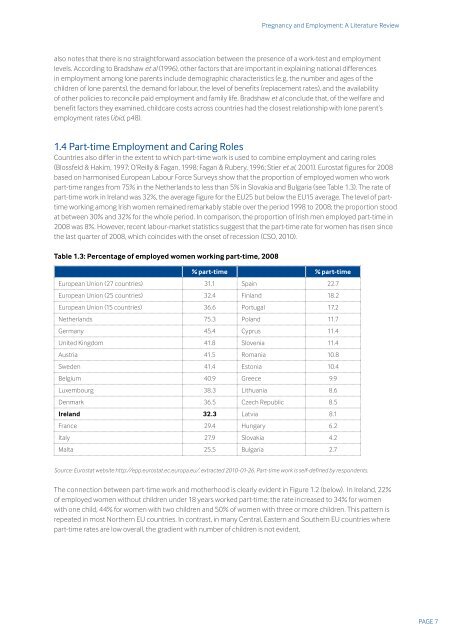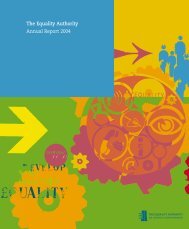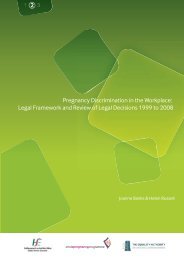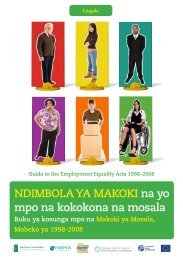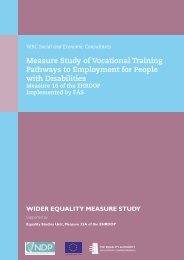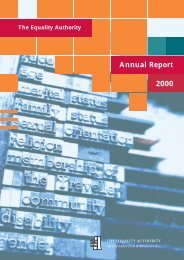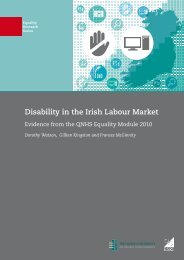Pregnancy and Employment: A Literature Review - Crisis Pregnancy ...
Pregnancy and Employment: A Literature Review - Crisis Pregnancy ...
Pregnancy and Employment: A Literature Review - Crisis Pregnancy ...
Create successful ePaper yourself
Turn your PDF publications into a flip-book with our unique Google optimized e-Paper software.
<strong>Pregnancy</strong> <strong>and</strong> <strong>Employment</strong>: A <strong>Literature</strong> <strong>Review</strong><br />
also notes that there is no straightforward association between the presence of a work-test <strong>and</strong> employment<br />
levels. According to Bradshaw et al (1996), other factors that are important in explaining national differences<br />
in employment among lone parents include demographic characteristics (e.g. the number <strong>and</strong> ages of the<br />
children of lone parents), the dem<strong>and</strong> for labour, the level of benefits (replacement rates), <strong>and</strong> the availability<br />
of other policies to reconcile paid employment <strong>and</strong> family life. Bradshaw et al conclude that, of the welfare <strong>and</strong><br />
benefit factors they examined, childcare costs across countries had the closest relationship with lone parent’s<br />
employment rates (ibid, p48).<br />
1.4 Part-time <strong>Employment</strong> <strong>and</strong> Caring Roles<br />
Countries also differ in the extent to which part-time work is used to combine employment <strong>and</strong> caring roles<br />
(Blossfeld & Hakim, 1997; O’Reilly & Fagan, 1998; Fagan & Rubery, 1996; Stier et al, 2001). Eurostat figures for 2008<br />
based on harmonised European Labour Force Surveys show that the proportion of employed women who work<br />
part-time ranges from 75% in the Netherl<strong>and</strong>s to less than 5% in Slovakia <strong>and</strong> Bulgaria (see Table 1.3). The rate of<br />
part-time work in Irel<strong>and</strong> was 32%, the average figure for the EU25 but below the EU15 average. The level of parttime<br />
working among Irish women remained remarkably stable over the period 1998 to 2008; the proportion stood<br />
at between 30% <strong>and</strong> 32% for the whole period. In comparison, the proportion of Irish men employed part-time in<br />
2008 was 8%. However, recent labour-market statistics suggest that the part-time rate for women has risen since<br />
the last quarter of 2008, which coincides with the onset of recession (CSO, 2010).<br />
Table 1.3: Percentage of employed women working part-time, 2008<br />
% part-time % part-time<br />
European Union (27 countries) 31.1 Spain 22.7<br />
European Union (25 countries) 32.4 Finl<strong>and</strong> 18.2<br />
European Union (15 countries) 36.6 Portugal 17.2<br />
Netherl<strong>and</strong>s 75.3 Pol<strong>and</strong> 11.7<br />
Germany 45.4 Cyprus 11.4<br />
United Kingdom 41.8 Slovenia 11.4<br />
Austria 41.5 Romania 10.8<br />
Sweden 41.4 Estonia 10.4<br />
Belgium 40.9 Greece 9.9<br />
Luxembourg 38.3 Lithuania 8.6<br />
Denmark 36.5 Czech Republic 8.5<br />
Irel<strong>and</strong> 32.3 Latvia 8.1<br />
France 29.4 Hungary 6.2<br />
Italy 27.9 Slovakia 4.2<br />
Malta 25.5 Bulgaria 2.7<br />
Source: Eurostat website http://epp.eurostat.ec.europa.eu/, extracted 2010-01-26. Part-time work is self-defined by respondents.<br />
The connection between part-time work <strong>and</strong> motherhood is clearly evident in Figure 1.2 (below). In Irel<strong>and</strong>, 22%<br />
of employed women without children under 18 years worked part-time; the rate increased to 34% for women<br />
with one child, 44% for women with two children <strong>and</strong> 50% of women with three or more children. This pattern is<br />
repeated in most Northern EU countries. In contrast, in many Central, Eastern <strong>and</strong> Southern EU countries where<br />
part-time rates are low overall, the gradient with number of children is not evident.<br />
PAGE 7


